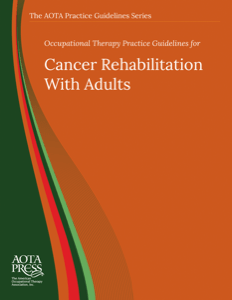Abstract
Cancer is the second-leading cause of death in the United States. Approximately 40% of people will be diagnosed with some form of the disease in their lifetime; men are at higher risk than women. By 2024, 22 million cancer survivors are expected to be living in the United States. For adult clients with cancer, occupational therapy practitioners provide interventions focused on rehabilitation, helping clients resume occupations and ADLs.
This Practice Guideline provides an overview of the evidence for the effectiveness of various occupational therapy interventions for adults with cancer who are undergoing rehabilitation. The occupational therapy process for adults with cancer is described, defining the domain and interventions that occur within acceptable occupational therapy practice. Evidence is presented on occupational therapy interventions with multidisciplinary programs, symptom management, psychosocial needs, physical activity, lymphedema management, CHAIH, PAMs, sexuality, and return to work. Appendixes include selected CPT® codes for occupational therapy, an explanation of evidence-based practice, and searchable evidence tables.
These guidelines should be useful to the many entities involved in providing occupational therapy services to individuals with cancer, such as occupational therapy practitioners, team members, educators, clients, families, caregivers, third-party payers, and policymakers.
Details
Table of Contents
Occupational Therapy Practice Guidelines for Cancer Rehabilitation With Adults
-
Front Matter
i2

- 1. Overview of Cancer and Cancer Rehabilitation xxii23
- 2. Occupational Therapy Process for Adults With Cancer 932
- 3. Best Practice and Summaries of Evidence 2750
- 4. Interventions in Multidisciplinary Rehabilitation Programs 2952
- 5. Interventions That Address Symptom Management 3154
- 6. Interventions That Address Psychosocial Needs 3356
- 7. Interventions That Address Physical Activity 3558
- 8. Interventions That Address Lymphedema Management 3760
- 9. Interventions That Address Complementary Health Approaches and Integrative Health 3962
- 10. Interventions That Use Physical Agent Modalities 4164
- 11. Interventions That Address Sexuality 4366
- 12. Interventions That Address Return to Work 4568
- 13. Implications of the Evidencefor Occupational Therapy Practice, Education, and Research 4770
- References 5174
-
Appendixes
6992

- Appendix A. Preparation and Qualifications of Occupational Therapists and Occupational Therapy Assistants 6992
- Appendix B. Domain and Process of Occupational Therapy 7194
- Appendix C. Selected CPT® Codes for Occupational Therapy Evaluations and Interventions forAdults With Cancer 7598
- Appendix D. Evidence-Based Practice 79102
- Appendix E. Evidence Tables and Risk-of-Bias Tables 83106
- Table E.1. Evidence Table for Occupational Therapy and Adult Cancer Rehabilitation 85108
- Table E.2. Risk-of-Bias Analysis for Studies Included in the Review of Evidence for Occupational Therapy and Adult Cancer Rehabilitation (Except SystematicReviews) 126149
- Table E.3. Risk-of-Bias Analysis for Systematic Reviews Included in the Review of Evidence for Occupational Therapy and Adult Cancer Rehabilitation 131154
